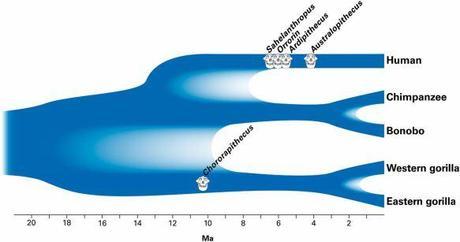Most scientists think that the human family split from the chimpanzee family around 5 – 7 million years ago. However, advances in technology are allowing us to gather a lot more genetic data a lot quicker. Whilst it took us more than a decade to sequence the genome of one human, in the subsequent decade we’ve sequenced 1,000 genomes! Armed with this bigger, better dataset researchers recalculated the chimp/human split; revealing it actually occurred 7 – 14 million years ago, more than twice as old as previously thought1.

The recalculated family tree of humans, chimps and other apes (but we don’t care about them)
And now for something completely relatively different:
Another upshot of all this new genetic data is the discovery that the age of a father influences the number of mutations in their children. Whenever cells divide there is a chance the copying process will make mistakes, leading to mutations. As such the older someone is the more mutations they’ll have in them; meaning they’re more likely to pass some on to any kids they have. This primarily affects men as they’re producing sperm throughout their lives (so it’s continuously dividing and accumulating mutations), whilst women aren’t continuously producing eggs.
When all is said and done this adds up to roughly 2 extra mutations in the kid for every year of the fathers’ age; meaning that men are “responsible” for about 75% of the mutations in their kids2.
And now to masterfully bring these two threads back together:
Many scientists objected to the 7 – 14 million year figure for the human/chimp split because of this research into the father’s age and mutations. The new date for the split was calculated by looking at the number of mutations that accumulate per generation (then working out how many generations would have to have passed to result in the number of mutations that separate us from chimps), but this age-mutation research indicates that this could be a highly variable figure, depending on the age of the parents3.
The researchers behind the 7 – 14 million year old figure (hereafter called the “old” figure because I’m too lazy to keep typing all that out) defended their conclusion, saying that whilst age could influence mutations per generation; it did not change drastically enough to render their findings invalid. Nonetheless, they admitted that more research should really be done into the subject to make sure they weren’t barking up the wrong (family) tree4.
At the very least more research could help refine the old figure. 7 – 14 million years is a lot of time, finding a more specific age for the split would be good.
And just last week more research on the subject was published! A team of researchers from England and the Netherlands examined the genomes of three generations of a chimpanzee family in exquisite detail; studying how the relationship between the age of fathers and mutations in children, as well as whether this influences the estimated date of human/chimp divergence. This investigation had some rather interesting conclusions2:
- Some parts of the genome may be more ‘susceptible’ to change, with 20% of mutations occurring close to another.
- Whilst the father’s age results in 2 mutations per year in humans, it’s 3 mutations per year in chimps. This is quite a significant difference (a 50% change) despite the fact we’re so closely related
- The extra age mutations in chimps means the father is responsible for 90% of the mutations in kids, compared to 75% in humans.
But the most important conclusion of all (to me at least) is that they were able to still calculate when humans and chimps diverged, taking into account the effect of father’s age. Their figure is a split 13 million years ago; consistent with the earlier old figures that have previously been criticised.
This is yet more evidence that our family is a lot older than we once thought. Also some interesting stuff about mutations, but I don’t know enough about genetics to be really blown away by that.
References
- Langergraber KE, Prüfer K, Rowney C, Boesch C, Crockford C, Fawcett K, Inoue E, Inoue-Muruyama M, Mitani JC, Muller MN, Robbins MM, Schubert G, Stoinski TS, Viola B, Watts D, Wittig RM, Wrangham RW, Zuberbühler K, Pääbo S, & Vigilant L (2012). Generation times in wild chimpanzees and gorillas suggest earlier divergence times in great ape and human evolution. Proceedings of the National Academy of Sciences of the United States of America, 109 (39), 15716-21 PMID: 22891323
- Oliver Venn, Isaac Turner, Iain Mathieson, Natasja de Groot, Ronald Bontrop, Gil McVean. 2014. Strong male bias drives germline mutation in chimpanzees. Science, 344(6189):1272-1275
- Gibb, G. C., & Hills, S. F. (2013). Intergenerational mutation rate does not equal long-term evolutionary substitution rate. Proceedings of the National Academy of Sciences, 110(8), E611-E611.
- Prüfer, K., Langergraber, K. E., Pääbo, S., & Vigilant, L. (2013). Reply to Gibb and Hills: Divergence times, generation lengths and mutation rates in great apes and humans. Proceedings of the National Academy of Sciences, 110(8), E612-E612.

